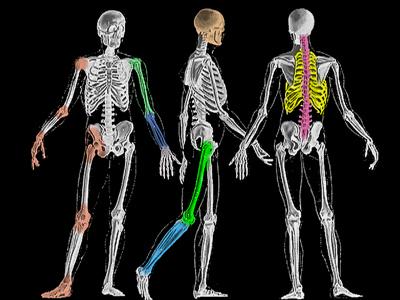 |
|
|
|
|
||||||||||||||||||||||||||
 |
||||||||||||||||||||||||||
|
The Wrist The wrist is a region and the wrist is a complex of joints. As a joint complex, it is made up of more than one bone. There are the ulna and radius and the navicular lunate, triquetrum, pisiform, greater multangular, multangular cuniform and hammate. Whew, that's ten! It must be up to something.
|
|
The wrist has two main joints. The less obvious one is that between the radius and ulna for pronation (palm down) and supination (palm up) movements. Wrist flexion and extension takes place predominately between the radius and the hand. At the elbow, the dominant bone of flexion and extension is the ulna. At the elbow the radius is The hand and wrist region is a good place to examine short and long bones. The carpus is a cluster of short bones set out in two rows of four each. The short bones start out as bones made totally of cartilage and thus invisible on x-ray. They grow evenly by general enlargement. Their centers begin to convert to bone substance and those centers take over more and more until the carpal bones are made of bone with just cartilage surfacing (the space you see between the carpal bones). There is a convenient aging scheme. One carpal bone begins to show (gets a boney center) at one year old. At two years there are two. There are three visible at three years of age. Take a wild guess about 4 & 5. Yup. But...what if the child is 5 and we see only two? That's a delayed BONE AGE. Bone age is the age as suggested by the maturity seen on x-ray. A delay in bone age may suggest a problem such as thyroid deficiency or other stuff. Not all of the differences are bad, though. Long bones get wider by bone layered under the tubular sleeve which wraps the long bones as a sausage skin wraps a sausage. That covering outside (peri) the bone (os) is called periosteum. Long bones grow longer from the ends by way of growth plates at one or both ends. The growth plate (physis) shows up as a clear line across the bone near the end. At the very end sitting on (epi) the physis is the epiphysis. The epiphysis typically forms the joint. The long bones of the region include the ulna (U) and radius (R), and the metacarpals and phalanges. In the image above, a ghosted blue outline defines example single bones. Notice how the radius (R) has what seems like a short flat bone on it near the carpus. That is the growing end of the radius itself (epiphysis and physis). A similar finding holds for the ulna (U). The ulna and radius have growth plates at both ends. The metacarpals (hand long bones) and phalanges (finger bones) have growth plates at only one end. Examples are also ghosted in blue above. All the phalanges (finger bones: distal, middle, and proximal) have the single growth plate at the proximal end. The metacarpals have the single growth plate at the distal end. The exception is the thumb which can be thought of as not so much having one less phalange (fuh-LAN-gee) but as having the proximal phalange promoted to metacarpal status. That would explain the part count and growth plate at the proximal end of the thumb metacarpal.
In the x-ray, the pisiform (pea shaped) bone is overlying the triquetrum (triangular). The lunate is moon shaped (quarter moon) and the navicular - alias scaphoid - bone is boat shaped which is what both names for it mean. The scaphoid (navicular) bone looks short here, huh? It isn't. It is pointing in line with the thumb. The ones to watch are the index and especially middle finger metacarpals, the capitate, the lunate and the radius. Why? That's the power line of the hand
construct. A punch delivered in line with the long finger metacarpal gets a well supported column of force delivery Seen from the side (edge) view, the stack of bones which make up the power line is better appreciated. Now we see the navicular (scaphoid) in line with the greater multangular on which the thumb sits. See that little wrinkle in the radius bone near the physis? That's a toros fracture. Toros is Greek for knuckle (not the bull, that's Taurus). These are often confused as being sprains because there is no big deformity and nothing dangling, but it hurts. Usually just protecting the part from another battering is enough. Such fractures don't need to "be set". Splints or mechanical protection is selected suited to the born-to-boogieness of the youngster.
|
|
|
||||||||||||||||||||